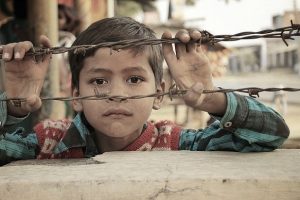2.5 Children growing up in challenging circumstances

Unfortunately, many children grow up in harsh circumstances. Poverty, wars, disasters, and/or displacements may be constant in a young child’s life. Most recently, the global pandemic affecting children and families throughout the world has compounded the stresses of children and families living in challenging circumstances.
The COVID-19 pandemic
The COVID-19 global pandemic began in 2020 and brought about social and economic change on an unprecedented scale, much greater than anything most of us have seen in our lifetimes or could imagine. Our understanding of the impact of COVID-19 on young children and families continues to unfold. Early research is providing insight regarding the impacts on children, families, and communities. As well, many local, national, and international organizations are providing information that seeks to support and reassure parents and help understand how to support children at home and, in some areas, in ECD programs and schools.
…the COVID-19 pandemic has the potential to profoundly affect young children’s development worldwide, through increases in poverty and food insecurity, loss of care-givers, heightened stress, and decreased health care. These realties can affect not only the entire life course of the child, but also future generations through physiologic, psychological, and epigenetic changes occurring in utero and during early development” (Hirokazu et al., 2020, p. 191).
Early in the pandemic, Hirokazu, Wuermli, Britto, et al. (2020) identified a number of immediate and long-term consequences of the global COVID-19 pandemic on early childhood development.
Much has happened since this article was written in May 2020.
Based on your experiences, how accurate were the predictions?
What other impacts has the pandemic had on children’s development?
The Harvard Center for the Developing Child has developed an online guide with links to a variety of relevant research and resources that provide information on the impact of COVID-19 as well as ways to support children and families during these uncertain times.
ECDAN, the Early Childhood Development Action Network, provides COVID-19 related resources from many parts of the world, some of which are available in multiple languages.
The far-reaching impacts of COVID-19 will not be known for years. In Latin America and the Caribbean, 60 leaders from 17 countries participated in a survey on early child development policies and strategies related to the pandemic. In the next article, Laura Chinchilla Miranda, former president of Costa Rica, reports on key findings of this survey.
UNICEF’s report, Preventing A lost decade: Urgent action to reverse the devastating impact of COVID-19 on children and young people (2021), states that “COVID-19 is the worst crisis for children in UNICEF’s 75-year history” (p.4). The report highlights the added challenges children face around the globe due to COVID-19, threatening the gains in child rights, and in meeting the Sustainable Development Goals. Visit the UNICEF website to see how data is being used to support a call to action for the world’s children. Scroll to the bottom of the page and view the video.
The world stands at a crossroads. We must decide to either protect and expand the gains made for child rights over years, or suffer the consequences of reversed progress and a lost decade for today’s children and young people, which will be felt by all of, everywhere.(UNICEF, 2021, p. 4)
Read the full UNICEF report, Preventing A Lost Decade: Urgent action to reverse the devastating impact of COVID-19 on children and young people. The report is also available in French, Spanish and Arabic.
As you learned in the Brain Development module, the biological imprint of stress is lasting. When young children face a daily life of constant adversity, the consequences can be devastating and carry forward long beyond childhood. The disruption in children’s and families’ lives as a result of natural disasters or other life-threatening events such as armed conflict can create a state of emergency and when occurring during the pandemic, only compound the stress and challenges.
Children in emergencies
The needs of women and children affected by emergencies have reached an unprecedented scale…. An emergency may be caused by conflict; disease outbreaks (such as COVID-19); or other events, such as massive food contamination, chemical or radionuclear spills, extreme weather and geological events. The emergency may be of varying length and severity, and the situation may change from day to day” (WHO, 2020).

The data on children in emergencies changes somewhat year to year but the numbers are consistently sobering. Pre-COVID-19 data indicated globally, 1 in 4 of the world’s children lives in a conflict or disaster zone (UNICEF, 2019). Many of them become separated from their families and are being enslaved, trafficked, abused, and exploited. Save the Children International (n.d.) states that “1 in 4 victims of modern slavery are children” (para 1). The following statistics provide a further glimpse at the scale of the impact on children and families. More than 30 million children around the world have been forced to flee their homes because of conflict. Between 1997 and 2017, the number of people in forced migration doubled, from 33.9 to 68.5 million. Refugees living in camps or other protracted situations remain for an average of 26 years, more than an entire childhood. Children under 5 living in these circumstances have 20 times higher rates of illness and death than the standard (Yoshikawa et al., 2018).
As it states on the following UNICEF website, “children pay the highest price of humanitarian crisis”. The website provides further information on the staggering numbers of children impacted by emergencies and explores specific topics such as gender-based violence in emergencies, recruitment of children by armed forces and, mental health and psychological support.
The following reading outlines the increased stresses that COVID-19 has layered on humanitarian crises.
How does COVID-19 present a double emergency for many children and families? How can the evidence help “make the case” for a “call to action”?
Emergencies such as natural disasters or armed conflict often require families to make unexpected and challenging journeys far from home. With each crisis, the world has seen large numbers of people displaced from their homes and communities, separated from their cultures, families, and support systems. During these periods of mobility and uncertainty, children are at greater risk of losing one or more family members or being separated from family members resulting in potentially additional trauma.
Consider… Ashma and her three young children in a refugee camp
Ashma wakes very early on her first morning in the refugee camp. It is already noisy and the canvas walls of the tent she shares with her three children provide no buffer to the noise…Read more
What is the situation with regard to refugees in your country? Are you a destination for refugees or are people leaving?
In what ways are children vulnerable when they are on the move?
The special issue of Migration Policy Practice (Vol.X, Number 2, April-June 2020), includes the article by You, Lindt, Allen et al., “Migrant and displaced children in the age of COVID-19: How the pandemic is impacting them and what can we do to help”.
Explore the UNICEF website “Migrant and Displaced Children”:
Supports for children and families
Global NGOs are critical to mitigating the effects of short- and long-term crises on children. Explore the next three links to read about the activities of PLAN International, Save the Children, and UNICEF.
Children, families, and communities are all affected socially and emotionally by armed conflict and we know that children are particularly vulnerable. The following NCF brief reviews the concept of “nurturing care”, and then provides compelling evidence as to why it is so important in humanitarian settings.
What are the challenges to providing nurturing care in humanitarian settings?
What can be done to lessen the effect of emergencies on children and families?
The brief highlights a number of programs – which did you find particularly interesting/inspiring?
We also know that nurturing care is a buffer against stress. The next reading, a brief prepared by the Moving Minds Alliance, presents an analysis of humanitarian responses to crises and shows that inadequate attention is paid to ECD and nurturing care.
Read the full paper “Early childhood development and early learning for children in crisis and conflict” that was commissioned for the 2019 Global Education Monitoring Report, Migration, displacement and education: Building bridges, not walls.
We learned about resilience in the Coping and Competence module and how ordinary experiences, what Dr. Ann Masten, professor at the Institute of Child Development at the University of Minnesota, calls “ordinary magic” buffers children against stress and supports resilience.
Listen to Masten discuss resilience and protective factors.
In the next clip, Masten discusses why some people seem to be more affected by crises than others.
Why does Masten advocate for supporting families and communities to become resilient, not just the children?
Emergency ECD programs
The following UNICEF video shows how ECD programs can support children and families during crises.
A massive humanitarian crisis occurred in 2017 when hundreds of thousands of Rohingya people from Myanmar crossed into neighbouring Bangladesh as refugees in a very short period of time. The world’s immediate reaction was to scramble to provide for basic needs such as food, water, and shelter for the refugees. In the next Early Childhood Matters article, read about BRAC’s response to implementing a humanitarian play lab, seeking to protect and help children cope with trauma.
The next Early Childhood Matters reading describes a project undertaken by the Sesame Workshop and the International Rescue Committee to support children displaced by the conflict in Syria.
Why is play considered so healing for young children?
Why did program organizers make particular efforts to include Rohingya cultural traditions in the program?
How do you think each of these initiatives might support resilience in children?
Explore the following resources to learn more about children living through challenging circumstances.
UNICEF and Handicap International have developed a series of six booklets to make sure that children and adolescents are included in all stages of humanitarian action (before, during, and after).
Learn more about the daily lives of millions of women and children living in fragile settings affected by conflict and natural disasters. The report by Save the Children takes a closer look at four countries affected by emergencies: The Democratic Republic of Congo, Syria, the Philippines, and the United States of America.


